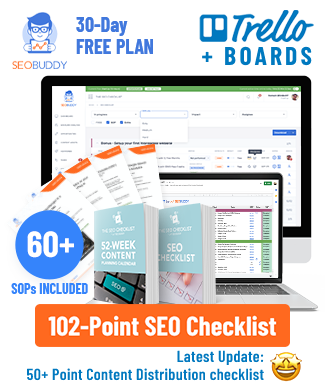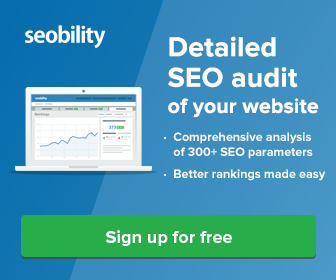On-page SEO is one of the only things you have full control of in SEO. And today, I'm going to take you through an on-page SEO checklist that we use to grow our search traffic consistently What's up SEOs? Abhishek here with ElysianTech, the SEO tricks that help you grow your search traffic, research your competitors and dominate your niche.
 |
| What Is On-Page SEO? |
Now, if you're new to on-page SEO, it's basically the practice of 'optimizing' web pages to help them rank higher in search engines. And while on-page work likely won't be enough to rank for competitive terms, it's a foundation to higher Google rankings and more traffic for your site. With that said, let's get to the checklist.
 |
| Step 1 |
The first step is to understand and match search intent. Search intent basically means the reason behind a searcher's query. For example, if someone searches for"buy headphones," they likely want to see category pages from eCommerce stores. And you don't have to guess what search intent is. Since Google gives preference to pages that their users are happy with, just search for your target keyword and analyze the types of pages that show on the first page. After all, user happiness essentially means satisfying search intent. So let's say you had a website where you sell supplements and you want to create a page targeting the keyword "best protein powder." If you look at the search results, you can tell right away from the titles that they're all blog posts that follow a list-styled format. So for this scenario, I wouldn't advise creating a product or category page targeting this keyword because if you're not matching intent, you probably won't rank. Now, while it's easy to stop here and start writing, I highly recommend actually visiting these pages to get a better understanding of what they've included in their posts. For example, if you look at this post, you'll see that they're primarily focusing on categorizing protein powders by type. Best grass-fed whey protein powder. Best tasting protein powder. They then go on to give you a description of that specific product and send it off by breaking down the pros and cons. And if you look at another one of the top 3 results, you'll also see that the focus is on types before brands. Analyzing the top results is like looking through the lens of Google. Their job is to return the most relevant results for any given query. Take note of search intent and make sure your page matches it.
 |
| Step 2 |
Step 2 is to increase the topical relevance of your page. We ran a study and found that on average, the #1 ranking page for a target keyword ranks for nearly a thousand other relevant keywords in the Top 10. So what you'll want to do is find related sub-topics to ensure your piece is thorough. And there are a few ways you can find these related subtopics. First, analyze the top-ranking pages and look for relevant keywords. So this time, you'll see related keywords like "whey," "isolate," "concentrate," "grams," and "calories." Second, use Google's autosuggest. Just type in your target keyword, and you'll see a few suggestions like "for women," "for men," "weight loss," "weight gain," "smoothies," and"bulking," which are all related to protein powder. Just make sure that these are in fact related sub-topics and not standalone topics of their own. To do that, Google the suggested keyword and if the results are completely different from the results for your main target keyword, chances are you should target the keyword with its own page.
#3. Use the People also ask box to find points worth covering. Here, you'll see common questions people areas king like "what is the healthiest protein powder," and "which whey protein is best for muscle building?" Finally, you can scroll down to the bottom of the page to see additional keywords and potential subtopics for your post. Now, the downside to these methods is that you're kind of guessing. So a better way to do this is to use the Ahrefs Content Gap tool, which is going to show us common keywords that the top pages rank for in Google. And to me, this is much more valuable since you're essentially looking at the exact keywords Google has ranked a single page for. So why wouldn't your page be able to rank for those same keywords? So I'm in the Content Gap tool and you'll see that I've pasted in a few of the top-ranking pages for the query "best protein powder" in the top section. And I've left the bottom section blank. What we're asking the tool to do here is how common keywords that any of these pages rank for where at least one of them ranks in the Top 10. And this is to ensure that our results are relevant since keywords in position 50 probably won't be very helpful. So let's run the search. And now you can see data that shows you which sub-topics you should cover. To narrow our list down even further, let's change the number of intersections, where all 3 pages need to rank in the Top 100. And we're down to around 140 relevant keywords to skim through. So you should talk about whey protein, you'll also see that "for women" is a recurring theme here. And people are also specifically looking for vanilla protein powder. Now, that you have a data-driven outline, you should be able to write your post and create content that perfectly matches the intent of your future visitors.
 |
| Step 3 |
Let's move on to step 3, which is to use short and descriptive URLs. In our study on various on-page ranking factors, we found a clear correlation between the number of characters in the URL and a page's ranking position in Google. Now, correlation doesn't mean causation, soI doesn't want you to take this advice as a be-all-end-all. So let's say that your page title was "11 Best Protein Powders in 2019." Now, if you're using a CMS like WordPress, it'll automatically change the URL slug to the title and replace spaces with dashes. This URL is longer than it needs to be. So as a general rule of thumb, use your target keyword as the URL slug. So in this case, I'd leave it as just "best protein powder" because it's short and descriptive. Now, there are a couple of other benefits worth noting. First, people are most likely to click the search results that best match their search query. And descriptive URLs can help cement your page as that result. Second, descriptive URLs tend to include your target keywords. And since people often use URLs as anchor text when linking to a page, it can be helpful. Now, if you already have URLs that are long and/or not descriptive, I wouldn't worry too much about changing them if you're getting a good amount of search traffic. For example, Medical News Today gets around 53 million search visits per month. And if we go to the Top pages report, which shows us their pages with the most organic traffic, you'll see that their pages still get a ton of search traffic, despite having numeric URL slugs.
 |
| Step 4 |
Now, step 4 is to add your target keyword in your title, meta description, and H1 tag if and when it makes sense. And there are two reasons why I highly recommend including your target keyword in your title tag, description, and H1 tag. #1. When we studied 2M keywords, we found that there was a small correlation between rankings and the strategic placement of exact-match keywords. And #2, it can help searchers quickly understand that your page is the most relevant for their search query. For example, let's say you want to find an article with reviews on refrigerators. So you attend Google and look for "refrigerator reviews." Now, if you were to figure out these two results, which one would you be more likely to click? Probably the first one, since it uses the words you utilized in your search query. In other cases, exact match keywords can look quite spammy. for instance, you'd not create a title like this simply because the keyword includes a little bit of search volume. So bottom line, you do not need to stuff exact-match keywords into your titles or perhaps content for the sake of it. you will be able to use synonyms, stop words, and connecting words. Google is sensible enough to figure things out. Just confirm your content is on point.
 |
| Step 5 |
Alright, step 5 could also be a brilliant low-hanging due to improve your on-page SEO. which is to optimize your images with alt tags. Image alt tags allow you to supply descriptive texts for images on your page. Here's what the code for a typical image looks like. And after you add the alt attribute, you'd basically describe the image by adding alt="your description." Now, there are some reasons why this could be important to do and do. First, when your image fails to load on your page, the alt text will appear as a replacement for the image. Second, 8.1 million Americans have a vision impairment. And oftentimes, they're going to depend on a screen reader. Alt text can help provide a more rich experience for your users. And third, alt text can facilitate your rank your images in Google images. John Mueller confirms this by saying: "Alt text is extremely helpful for Google Images — if you would like your images to rank there." gazing our Google Search Console data, you may see that within the past 3 months we've had around 4 million impressions from our images alone, which led to over 5,000 clicks to our pages. Bottom line: it doesn't take much effort to feature some words and describe your images, which can cause big returns.
 |
| Step 6 |
Alright, step 6 is to feature structured data where it's sensible. and that i am sure you've seen search results with things like star ratings. this is often often the results of review structured data, which could have a positive impact on your click-through rates. But using this is often not nearly increasing visibility in Google search since not all schema types create additional details within the SERP. It's about making it easier for search engines to know what your pages are about. So while it's not a right away ranking factor, it should still facilitate your rank higher in Google. Here's what John Mueller had to say: "There's no generic ranking boost for structured data usage. However, structured data can make it easier to know what the page is about, which can make it easier to signifies where it's relevant (improving targeting and maybe ranking for the proper terms)." you'll use Google's Structured Data Markup Helper to quickly generate your own code.
So for this text, I'll select the title of the article and set the property because the name. so I'll do the identical thing for the Author property. Once you're all done, click the Create HTML button and a piece of JSON code will occur, which you'll then increase your page as instructed here. Or if you're a WordPress user, there are plugins out there that make adding markup super-easy. be at liberty to check out our video on our WordPress SEO plugins setup, which covers a codeless structured data plugin.
 |
| Step 7 |
Alright, step 7 is to form sure your content is simple and straightforward to read. Creating clear and concise content can help search engines piece together what your content is all about. But what's even more important in my opinion, is making it simple and super easy to read for real people. It's believed that Google looks at user signals liked well time and time on page to influence rankings. So if your content is complicated and difficult to understand, your visitors are visiting be heading straight for the rear button, which isn't an honest thing. Here are some tips to boost readability. Avoid big words if you are doing not must use them. as an example, don't say "proximity" rather than that you simply can say "near." Use short sentences and paragraphs. this can simplify the read for users as big walls of text is intimidating. Finally, as a general rule of thumb, write as you speak. In fact, everything that you simply have watched during this video is scripted. And if you've made it this far, it's because it absolutely was easier to digest. Had I written the script in an instructional tone, you'd have probably been gone couple of minutes ago. To benchmark readability, you will be able to use a free tool called Hemingway editor. Just paste your content in there and you'll get a readability score. I suggest aiming for around a 5th to 6th-grade level. For the foremost part, this is often often the on-page SEO checklist we use at Ahrefs, and it works tremendously well. Now, if there's anything I've missed that you just simply find to work particularly well, let me know within the comments. And if you enjoyed this article, ensure to share, and subscribe for more actionable SEO and marketing tutorials. So keep grinding away, put your best foot forward for each step, and We'll see you within the subsequent tutorial.










0 Comments:
Post a Comment